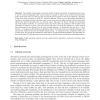Free Online Productivity Tools
i2Speak
i2Symbol
i2OCR
iTex2Img
iWeb2Print
iWeb2Shot
i2Type
iPdf2Split
iPdf2Merge
i2Bopomofo
i2Arabic
i2Style
i2Image
i2PDF
iLatex2Rtf
Sci2ools
103
Voted
SIROCCO
2010
2010
Traffic Grooming in Star Networks via Matching Techniques
The problem of grooming is central in studies of optical networks. In graph-theoretic terms, it can be viewed as assigning colors to given paths in a graph, so that at most g (the grooming factor) paths of the same color can share an edge. Each path uses an ADM at each of its endpoints, and paths of the same color can share an ADM in a common endpoint. There are two sub-models, depending on whether or not paths that have the same color can use more than two edges incident with the same node (bifurcation allowed and bifurcation not allowed, resp.). The goal is to find a coloring that minimizes the total number of ADMs. In a previous work it was shown that the problem is NP-complete when bifurcation is allowed, even for a star network. In this paper we study the problem for a star network when bifurcation is not allowed. For the case of simple requests - in which only the case of g = 2 is of interest - we present a polynomial-time algorithm, and we study the structure of optimal solution...
| Added | 29 Oct 2010 |
| Updated | 29 Oct 2010 |
| Type | Conference |
| Year | 2010 |
| Where | SIROCCO |
| Authors | Ignasi Sau, Mordechai Shalom, Shmuel Zaks |
Comments (0)

